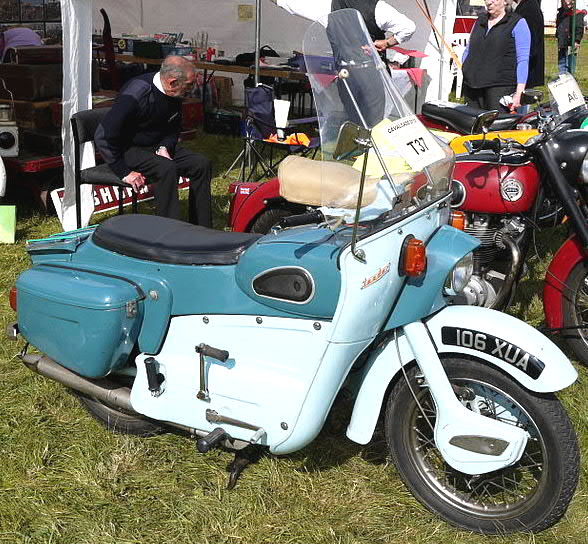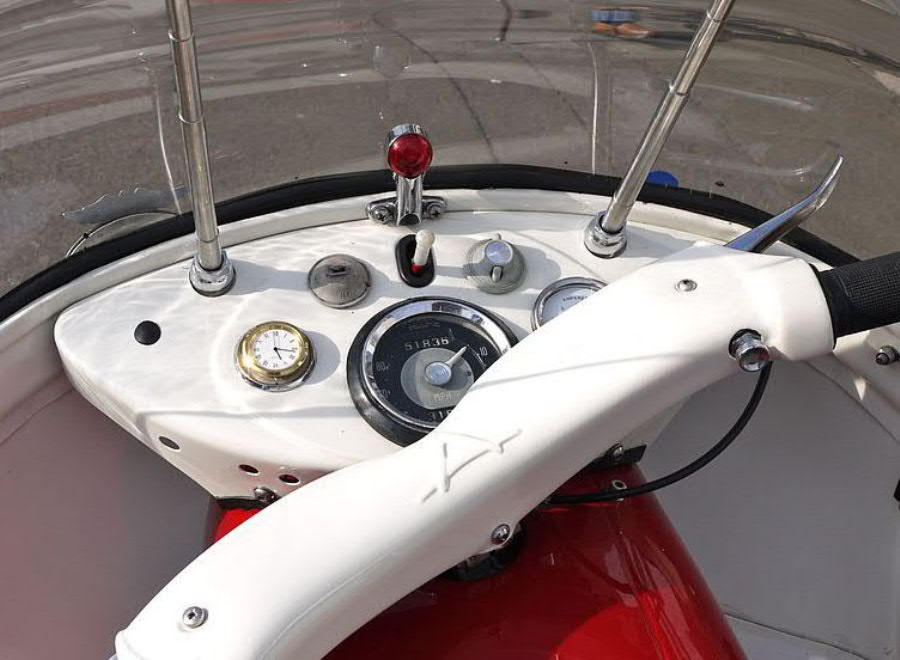Ariel Leader on:
[Wikipedia]
[Google]
[Amazon]
The Ariel Leader was a British
 Designed by
Designed by  As well as a full body, the standard Leader features included a headlight trimmer, an extendable lifting handle for easy centrestand use, and a permanent windscreen mounting. Factory listed options included: integral hard-luggage
As well as a full body, the standard Leader features included a headlight trimmer, an extendable lifting handle for easy centrestand use, and a permanent windscreen mounting. Factory listed options included: integral hard-luggage
 This was a cheaper, stripped Leader produced from 1959 and was developed into the Golden Arrow sport version in 1961.
A sister-machine designated Ariel Arrow 200 – with a smaller capacity of 200 cc, achieved by reducing the bore to 48.5 mm from 54 mm whilst retaining the same stroke – was available from 1964 to bring it into a lower tax band and benefit from lower UK rider insurance premiums.
In his 1964 ''
This was a cheaper, stripped Leader produced from 1959 and was developed into the Golden Arrow sport version in 1961.
A sister-machine designated Ariel Arrow 200 – with a smaller capacity of 200 cc, achieved by reducing the bore to 48.5 mm from 54 mm whilst retaining the same stroke – was available from 1964 to bring it into a lower tax band and benefit from lower UK rider insurance premiums.
In his 1964 ''
Real Classic Guide
Ariel Leader
motorcycle
A motorcycle (motorbike, bike; uni (if one-wheeled); trike (if three-wheeled); quad (if four-wheeled)) is a lightweight private 1-to-2 passenger personal motor vehicle Steering, steered by a Motorcycle handlebar, handlebar from a saddle-style ...
produced by Ariel Motorcycles
Ariel Motorcycles was a British maker of bicycles and then motorcycles in Bournbrook, Birmingham. It was an innovator in British motorcycling, part of the Ariel marque. The company was sold to Birmingham Small Arms Company, BSA in 1951 but the ...
between 1958 and 1965. A radical design, the Leader was fully enclosed with an integral windscreen and was the first British motorcycle to have optional flashing indicators. After a few years of success, Ariel could no longer compete against Japanese imports. The last Ariel Leader was made when the factory closed in 1965.
Development
Val Page
Valentine Page (1891–1978) was a British motorcycle designer. He worked for leading UK marques including JAP, Ariel, Triumph, and BSA. Page was an innovator whose radical designs include the Triumph 6/1; BSA Gold Star, M20, and A7; Ari ...
and Bernard Knight, The Ariel Leader featured a 250 cc two-stroke engine
A two-stroke (or two-stroke cycle) engine is a type of internal combustion engine that completes a Thermodynamic power cycle, power cycle with two strokes of the piston, one up and one down, in one revolution of the crankshaft in contrast to a f ...
suspended from a monocoque
Monocoque ( ), also called structural skin, is a structural system in which loads are supported by an object's external skin, in a manner similar to an egg shell. The word ''monocoque'' is a French term for "single shell".
First used for boats, ...
'backbone' fabricated from 20-gauge pressed steel panels. The fuel tank was hidden inside this structure and accessed by lifting the hinged dual seat. A dummy petrol tank was used for storage and was large enough to fit a spare crash helmet. It was the fully enclosed body, similar to that developed by Phil Vincent
Philip Conrad Vincent (14 March 1908 – 27 March 1979) was a British motorcycle designer and manufacturer. Founder of Vincent Motorcycles, his designs influenced the development of motorcycles around the world.
Early life
Philip Conrad Vince ...
for the innovative Vincent Black Prince, that was most prominent, as none of the working parts of the motorcycle were visible.
panniers
A pannier is a basket, bag, box, or similar container, carried in pairs either slung over the back of a beast of burden, or attached to the sides of a bicycle or motorcycle. The term derives from a Middle English borrowing of the Old French '' ...
, the first flashing indicators on a British motorcycle, a dash-mounted parking light, windscreen top-extension (adjustable on the move), a rear rack and a clock aperture built into a dashboard, which was closed by an Ariel badge when not fitted.
Launch
Launched in mid-1958, the Leader claimed to offer the comfort of a scooter with the performance of a motorcycle. It sold well, and it won the ''Motor Cycle News
''MCN'' or ''Motor Cycle News'' is a UK weekly Motorcycle, motorcycling newspaper published by Bauer Verlagsgruppe, Bauer Consumer Media, based in Peterborough, United Kingdom. It claims to be "the world’s biggest weekly motorcycle newspape ...
'' Motorcycle of the Year award in 1959. Ariel supported the launch with a range of options, which was unusual at the time. Hence few of the 22,000 Ariel Leaders produced were the same. Colour schemes, many of them two-tone, were also a break with tradition. They included Oriental Blue or Cherry Red with Admiral Gray accents.
Ariel Arrow
 This was a cheaper, stripped Leader produced from 1959 and was developed into the Golden Arrow sport version in 1961.
A sister-machine designated Ariel Arrow 200 – with a smaller capacity of 200 cc, achieved by reducing the bore to 48.5 mm from 54 mm whilst retaining the same stroke – was available from 1964 to bring it into a lower tax band and benefit from lower UK rider insurance premiums.
In his 1964 ''
This was a cheaper, stripped Leader produced from 1959 and was developed into the Golden Arrow sport version in 1961.
A sister-machine designated Ariel Arrow 200 – with a smaller capacity of 200 cc, achieved by reducing the bore to 48.5 mm from 54 mm whilst retaining the same stroke – was available from 1964 to bring it into a lower tax band and benefit from lower UK rider insurance premiums.
In his 1964 ''Motor Cycle
A motorcycle (motorbike, bike; uni (if one-wheeled); trike (if three-wheeled); quad (if four-wheeled)) is a lightweight private 1-to-2 passenger personal motor vehicle steered by a handlebar from a saddle-style seat.
Motorcycle designs var ...
'' road test, Bob Currie
Robert Frank Currie (26 April 1918 – 25 July 1988) was an English motorcycling writer and road tester, who later became a magazine editor and book author. Mainly known for his UK journalism work with ''Motor Cycle'', a UK weekly motorcycle m ...
reported good performance, with an absolute top speed – with "''rider lying flat, of course''" – of 74 mph and a cruising speed which could be held at 60 mph.
The bike had the usual Arrow ivory background colour, but with the tank and chaincase finished in either aircraft blue or British Racing Green
British racing green, or BRG, is a colour similar to '' Brunswick green'', '' hunter green'', '' forest green'' or '' moss green'' ( RAL 6005). It takes its name from the green international motor racing colour of the United Kingdom. This origin ...
, and tank badges with the legend "Arrow 200".
After the Ariel factory closure, in 1967 Ariel marketed its last motorcycle, the Arrow 200 produced for a time by BSA.
In 1960, a prototype Arrow with a 349 cc twin-cylinder four-stroke engine
A four-stroke (also four-cycle) engine is an internal combustion (IC) engine in which the piston completes four separate strokes while turning the crankshaft. A stroke refers to the full travel of the piston along the cylinder, in either directi ...
was made to sell alongside the Ariel Leader. The budget engine, designed by Val Page to do , was canted to fit the Arrow frame. It was thought the initial power output could have been increased to , but development money ran out and the project was dropped.
Demise
Later in the course of production, Ariel two-strokes failed to compete against Japanese imports. BSA closed the Ariel factory in 1965, but continued to make Ariel Arrows until 1967. In 1970 BSA revived the brand for theAriel 3
Ariel 3 (UK 3 or United Kingdom Research Satellite 3) was a satellite in the Ariel programme, a satellite partnership between the US and UK. Three of the onboard experiments continued research from the first two missions and two experiments wer ...
; a 49 cc trike that was a commercial failure.
Notes
References
See also
*List of motorcycles of the 1950s
This a listing of motorcycles of the 1950s, including those on sale, introduced, or otherwise relevant in this period.
* AJS 18 (1949–1963)
External links
{{Commons category, Ariel LeaderReal Classic Guide
Ariel Leader
Leader
Leadership, is defined as the ability of an individual, group, or organization to "", influence, or guide other individuals, teams, or organizations.
"Leadership" is a contested term. Specialist literature debates various viewpoints on the co ...
Motorcycles introduced in 1958
Two-stroke motorcycles